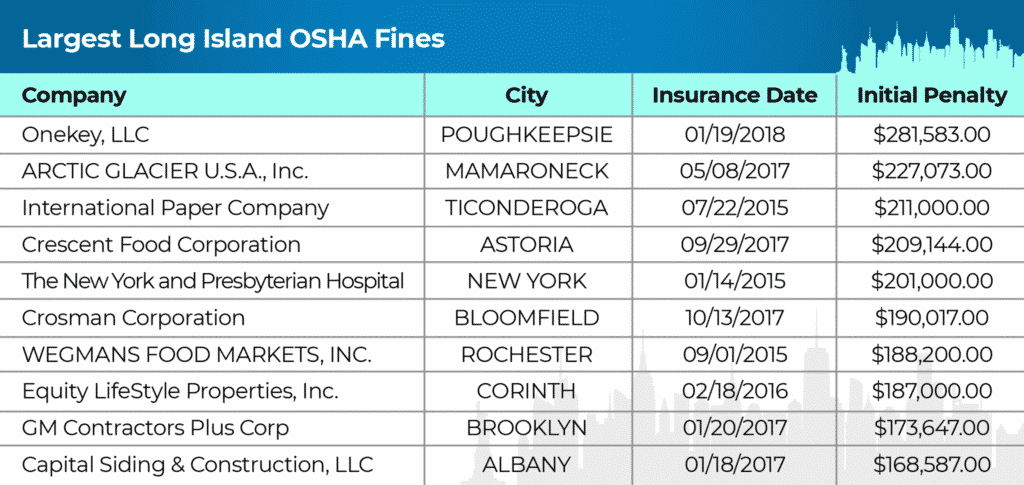In 2015, OSHA floated an idea concerning its intention to increase its penalties by as much as 80 percent. For advocates who always lamented that the rates then charged by OSHA were too low, this was welcome news. Fast forward to 2018, the current rates makes one realize that OSHA made good of its intention. Previously, willful violation attracted an average penalty of $70,000, the figure goes as high as $127,000 today. The same applies to repeat violations. On the other hand, serious violations attracted a penalty of $7000 on average, the figure today goes as high as $12,000. The pertinent question remains whether these increments actually serve the intended purpose, that of encouraging accident watchfulness by organizations.
A Gap in Current Laws
Judging from the prevalent cases of high OSHA fines imposed, it appears that the organization has failed to achieve the intended goal, that of prompting companies to enhance and ensure the safety of their workers. Partly, this is due to systemic deficiencies in the law, among them being challenges in successfully prosecuting violators, such as those who use ‘ignorance’ defense to negotiate a resolution. However, serious strides have been made in relation to this, more so in the wake of a recent case in Athens, GA, where the Eleventh Circuit court rejected the contractor’s argument against ‘willful’ safety violation, citing that such would preclude classification of a violation as willful, and which might perversely allow contractors to cite ineffective training as defense against serious charges.
New OSHA Fines Significantly Higher

Take, for example, the case of Rynone Manufacturing Corp, that OSHA recently fined a total of $70,078 based on 9 cases of serious violations. While some of these violations attracted fines of $4800 or thereabouts, others attracted fines of up to $11,408, a new high compared to penalties exacted on similar cases over the previous years. The violations cited varied extensively, ranging from hazards created by improper stacking or storing of instruments that could easily tumble, thereby causing physical harm to employees, failure to ensure employee protection from machine injuries, failure to institute a program for regular equipment inspection, as well as failure to accord the necessary safe machine operation training.
Is OSHA a Law Enforcement Agency?
More interesting, however, is the fact that despite OSHA being effectively a law enforcement agency, following the increase in penalty amount, its commitment to fast-track complaints and ensure adherence to set safety rules and guidelines, it still finds it difficult making public the hefty penalties it exacts on different companies across the country. In fact, of the cases currently in the public domain, no more than 20 percent have been through OSHA press releases. Does OSHA perceive such releases as hurtful to the companies or is it just a systemic practice designed to keep information out of the public domain? As a law enforcement agency, it needs to be accountable to the public. Reports on its actions, or inaction, would not be too much for the public to ask.
Use (or Non-Use) of Press Releases
If press releases were an embarrassment to the implicated employers, then logic dictates that such is a good thing since it discourages others against reckless disregard for employee safety. Who pays the price for non-disclosure of information pertaining to activities for which OSHA fines companies massive amounts? Despite OSHA’s reticence concerning the essence of publicizing its enforcement activities, select members of the press have taken it upon themselves to make public what OSHA intends to keep a secret.
Cases exist where media briefings would have gone a long way in educating the masses on some of the ills associated with certain organizational practices. For instance, the case of Aspire of Western New York, recently fined $65,186 by OSHA for safety violations. The firm, which caters to people with disabilities, would have highlighted the level of negligence for which the company was fined. Instead, OSHA chose to keep the details under wraps, thus denying the public vital information.
In a similar breadth, Ream Roofing Associates Inc., NY, which was recently fined $145,382 on two counts of serious violations and one count of willful violation, would have formed a perfect case study on the effectiveness of public engagement and awareness of safety standards under which employees operate. In this case, the company had allegedly failed to secure a temporary wood decking in certain areas of the roof, an accident followed that resulted in the death, from head trauma and bone fracture, of an employee. If OSHA could take the initiative of making these cases public, and subsequently educating the public on proactive, rather than reactionary measures, then such accidents would reduce drastically across states. But OSHA’s disdain for press releases remains charming, even as evidence mounts that it has transformed itself into a law enforcement agency.

The Impact Of Marijuana Legalization
Would New York legalizing recreational marijuana increase road accidents? We took a look at the stats in our latest study.
View StudyThe Law Office of Siler & Ingber, LLP
Phone:
1.516.294.2666
Address:
301 Mineola Blvd. Mineola, NY 11501
Subscribe to our Newsletter
SubscribeThis is a unique website which will require a more modern browser to work!
Please upgrade today!
